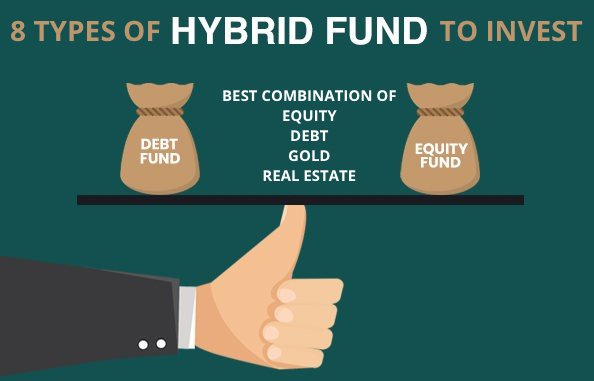Home > Blog > Blog Detail

Hybrid mutual funds are a class of mutual funds which invest in more than
one asset class. Mostly they are combinations of Equity, Debt, and sometimes it
also includes gold and real estate. The principal reasons behind hybrid funds
are – diversification of portfolio by asset allocation and correlation. In
diversification, we decide to have more than one asset class in the portfolio,
in Asset Allocation we decide how to distribute wealth among various asset
classes, and in correlation we compare the co-movement of getting returns from
the assets. As the risk and factors affecting the returns are the same in
nature for the investment options in the same asset class, it tends to display
a high level of correlation in returns, whereas in comparison the investment
options across more than one asset class will show less correlation in returns.
Portfolio risk can be minimised by combining more than one asset that has a
little correlation. Hybrid mutual fund schemes provide diversification for
investment within multiple asset classes to achieve maximum returns at minimum
possible risk. The allocation to each asset class is decided by the AMC elected
professional fund manager based on the investment objective of the fund and the
market condition.
Read More:
Best Short Term Investment Plans For Better Financial Future
Types of Hybrid Funds
1. Balanced Hybrid Funds: Here one would be investing minimum 40% and maximum 60% in both equity
and debt asset classes. The purpose here is to generate long term returns by
investing in equity class and balancing the risk by investing in debt funds allocation.
2. Multi Asset Allocation Fund: Here one would be investing in at least three different asset classes.
Each asset class should have a minimum 10% of investment. So this fund gives
the investor the option to invest in more than one asset class. The exact
allocation is decided by the fund manager based on their expertise.
3. Aggressive Hybrid Funds: Here one would mandatory be investing at least 65% and up to 80% in equity
asset class and remaining in debt asset class. This would provide high returns
with reduced risk considering small investment in debt asset class. There is
also a taxation benefit.
4. Conservative Hybrid Funds: Here the investment in equity is on the lower side i.e. 10 to 25%, the
rest is invested in debt asset funds. The motto here is to generate maximum
stable returns and to get a little high return. Its good option for people
looking for stability with a little risk appetite.
5. Dynamic Asset Allocation or Balanced Advantage Fund: Here the allocation is
truly dynamic and can shift from 100% debt to 100% equity on the basis of
recommendation of the financial model and fund manager. This is suitable for
investors who want to automate their investments as per market conditions.
6. Monthly Income Fund: These are debt-oriented hybrid mutual funds which give a fixed return
every month to the investor by providing a withdrawal plan. Here the equity
investment is on the lower side considering its volatile nature. Here the
returns are paid out to the investor in the form of dividend and the schedule
of the payout depends on the selection of the investor and his funds, hence it
could be annual, half-yearly, quarterly or every month.
7. Equity Savings Fund: These are for investors with moderate risk appetites as risk in these
funds is lower compared to other schemes. Here the funds try to balance between
equity, derivative and debt funds. 65 to 100% is in equity assets and 0 to 35%
is in debt asset class.
8. Arbitrage Fund: Here the options are buying in the cash market and then accordingly selling
in the futures market to generate returns by making profits due to the
difference in both markets. Fund managers are always vigilant for such
opportunities to provide maximum returns to the investors. But availability of
such opportunities is not always possible. In such times the funds are invested
in debt securities and cash.
Read More:
3 frameworks to save money: Best time to start saving is now
Bottom LineThere are Mutual fund options for everyone based on
their needs, goals and investment availability. One can plan and go ahead
according to their risk appetite and timeline for which they want to be invested.
<!–
Being smart and earning more is one thing, but managing money is another. As a smart investor if you started to do investment in this Financial New Year then it’s great news!! But how about reviewing it periodically???
Well, building a strong investment portfolio is not enough to create financial wealth. One must have to review and monitor it regularly. If you intermittently review your investment planning and investment portfolio, you can make sure that it’s still serving your financial goals or not. Sometimes your focus has changed towards life and therefore your financial goals have switched too
Regardless of any major life events, it’s good practice to review your investment portfolio on an annual basis or even often you can do it. In this blog, we will detail out the steps to work on while reviewing your investment portfolio.
To start with the review process, first collect every single piece of the information about your investment. List them in a diary. This includes all your SIP, Mutual fund, stocks, bonds, fixed deposits, LIC policies, EPF and PPF balance. Now, you have to look at your portfolio, where did you invest your money and what are the current market updates on that. After that, make a valuation of each investment. This activity is a lot easier and can be done in a couple of minutes. You can go digitally to have a proof for the future rather than hand written notes. You can make a clear list through Excel or Google spreadsheets.

The most crucial element is to set financial goals. Though you have finalised it before investment but when you go through the process of review. If any major changes happen in your life, like a new job, health issue, planning or education of kids etc., then you must evaluate your financial goals to get the maximum return in future
If your financial situation and goals have changed, so your investment strategy and asset allocation has to be changed accordingly. The ratio of stocks and bonds is termed as asset allocation. If you are planning for the long term, you may prefer to seek higher risk assets in terms of shares or equities. If you are starting to invest later in life, you may prefer lower risk such as fixed income. So, make necessary adjustments suitably.

To build wealth it is advisable to build a diversified portfolio. Well, don’t take it as investing in every big name which is trending in the market. As they don’t remain high all the time. Thus, portfolios must be diversified with more asset allocation. It will not only improve your return but also reduce market risk. Eventually, diversification will keep you safe and prevent any loss.
Tax implications can reduce return. This is the vital step to be taken while reviewing an investment portfolio. First of all, get the right knowledge about tax implications of your investments. To understand the action you need to review the portfolio at the end of the financial year.
There is no certain limit to reviewing your portfolio at the end of the financial year. You may review it twice a year to avert from loss and generate more return. However, it may pave the way to erroneous decisions if it is made in a hurry. So, keep calm and start reviewing. You will have the greatest benefits from your finances.




